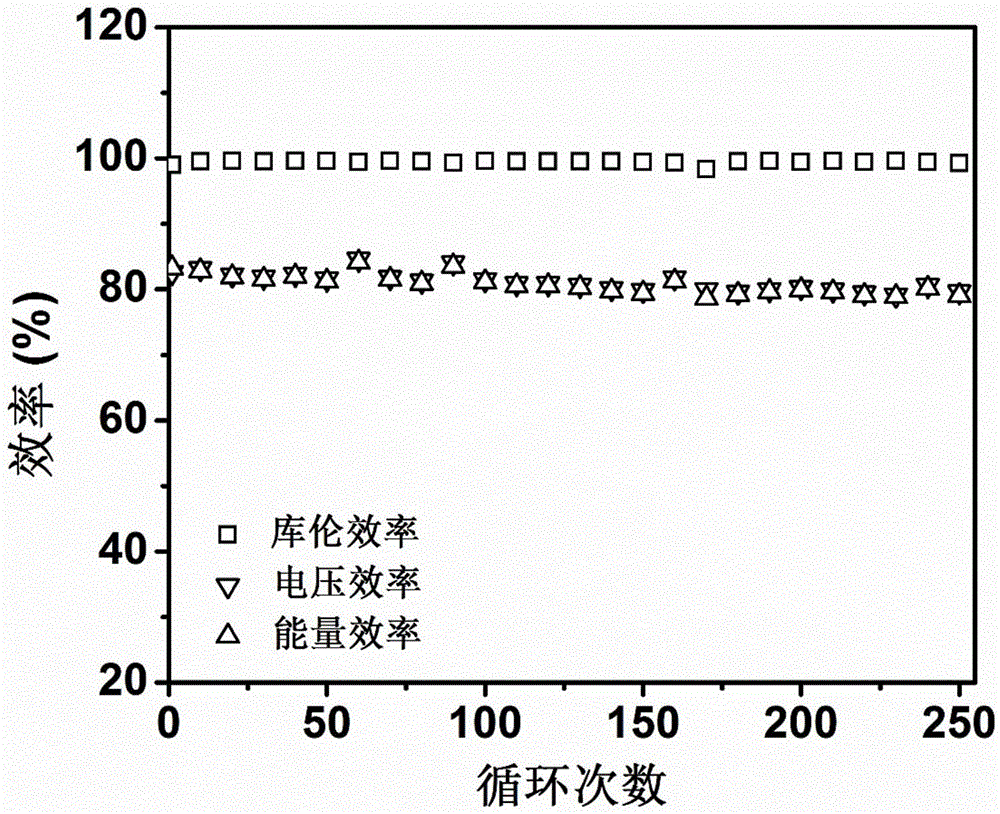Proton-conducting membrane for flow batteries and preparation method thereof
An ion-conducting membrane and membrane-forming technology, which is applied in the field of flow batteries, can solve problems such as limiting the popularization and application of membranes, and difficulty in further improving ion selectivity.
- Summary
- Abstract
- Description
- Claims
- Application Information
AI Technical Summary
Problems solved by technology
Method used
Image
Examples
preparation example Construction
[0025] The preparation method of a kind of polymer ion-conducting membrane according to the present invention comprises:
[0026] Step 1) Chloromethylation of polymers: polymers with excellent thermal stability and chemical stability, 1,4-dichloromethoxybutane, trifluoroacetic acid, zinc in a molar ratio of 1:5:1.1 : 1.5 Dissolve in the first type of organic solvent to form the solution to be reacted in an appropriate solvent and carry out stirring reaction at 30-50°C for 0.5-6h, pour the reaction mixture into the precipitant for precipitation after the reaction, and then filter sequentially , washing and drying to obtain a polymer containing chloromethyl;
[0027] Step 2) tertiary amination of the polymer: the polymer containing chloromethyl obtained in step 1, the phenol containing one or more tertiary amine groups or its derivatives and the alkali metal carbonate according to the amount of substance 1:1.2:1.1~2 is dissolved in the second type of organic solvent to form a s...
Embodiment 1
[0045] Step 1) Chloromethylation of polymers: 10 g of polysulfone, 1,4-dichloromethoxybutane, trifluoroacetic acid, and zinc were dissolved in dichloroethane at a molar ratio of 1:5:1.1:1.5 Form the solution to be reacted in a suitable solvent and carry out a stirring reaction at 30°C for 0.5h, pour the reaction mixture after the reaction into a precipitant for precipitation, and then filter, wash, and dry in sequence to obtain a polymer containing chloromethyl ;
[0046] Step 2) tertiary amination of the polymer: the chloromethyl-containing polymer, 2,4,6-tris(dimethylaminomethyl)phenol and cesium carbonate obtained in step 1 are in a mass ratio of 1:1.2 : 1.1 Dissolve in N,N-dimethylformamide to form a solution to be reacted, heat and reflux at 100°C for 12h, filter with suction, pour the mixture obtained after suction filtration into ethanol for precipitation, then filter, wash and dry in sequence , to obtain the tertiary amination product;
[0047] Step 3) Film formation...
Embodiment 2
[0057] Step 1. Chloromethylation of polymers: Dissolve 10g of polyethersulfone, 1,4-dichloromethoxybutane, trifluoroacetic acid, and zinc in dichloroethane at a molar ratio of 1:5:1.1:1.5 Form the solution to be reacted in a suitable solvent and carry out the stirring reaction at 35 ° C for 1 h, pour the reaction mixture after the reaction into ethanol for precipitation, and then filter, wash and dry in sequence to obtain a polymer containing chloromethyl;
[0058] Step 2, tertiary amination of polymer: the polymer containing chloromethyl, 2,6-bis(methylaminomethyl)-4-methyl-phenol and cesium carbonate obtained in step 1 are compared according to the amount of substance 1:1.2:1.5 was dissolved in N,N-dimethylformamide to form a solution to be reacted, heated and refluxed at 90°C for 12 hours, filtered with suction, and the mixture obtained after suction filtration was poured into ethanol for precipitation, and then filtered successively, Washing and drying to obtain a tertiary...
PUM
 Login to View More
Login to View More Abstract
Description
Claims
Application Information
 Login to View More
Login to View More - R&D
- Intellectual Property
- Life Sciences
- Materials
- Tech Scout
- Unparalleled Data Quality
- Higher Quality Content
- 60% Fewer Hallucinations
Browse by: Latest US Patents, China's latest patents, Technical Efficacy Thesaurus, Application Domain, Technology Topic, Popular Technical Reports.
© 2025 PatSnap. All rights reserved.Legal|Privacy policy|Modern Slavery Act Transparency Statement|Sitemap|About US| Contact US: help@patsnap.com


